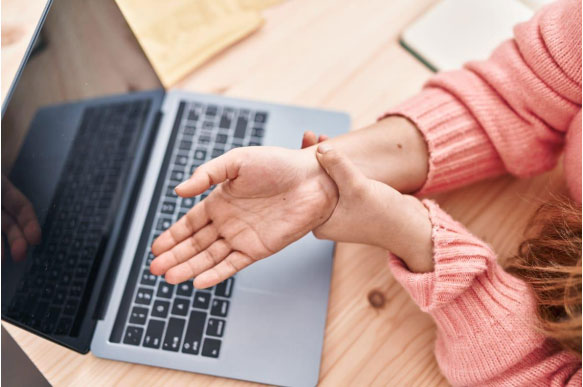De Quervain’s Tenosynovitis is a painful inflammation of the tendons that run along the thumb side of the wrist.
Tendons are strong bands of tissue that connect muscles to bones, and they glide smoothly within a protective sheath. When this sheath becomes irritated or inflamed, it leads to pain and swelling — this condition is called tenosynovitis.
Common Causes
This condition usually develops from overuse or repetitive wrist and thumb movements. Activities that can trigger or worsen it include:
- Playing racket sports (like badminton or tennis)
- Lifting or carrying a baby frequently
- Typing or texting extensively on mobile devices
- Any repetitive gripping, twisting, or lifting motions
Symptoms to Watch For
You may notice one or more of the following:
- Pain when moving your thumb or wrist
- Discomfort or pain when making a fist
- Swelling and tenderness on the thumb side of your wrist
- A creaking or catching sensation when the tendon moves through its sheath
If left untreated, the pain may worsen and interfere with daily activities.
How It’s Diagnosed
Your doctor will usually make the diagnosis through a physical examination. In some cases, an X-ray may be done to rule out a fracture or other bone problems.
Treatment Options
The good news is — most cases improve with conservative management.
Here’s what treatment may include:
- Ice therapy: Apply an ice pack to the thumb and wrist for 20–30 minutes every 3–4 hours to reduce swelling and pain. (Avoid direct contact with skin to prevent ice burns.)
- Wrist and thumb splint: Helps rest and support the affected tendons.
- Activity modification: Avoid activities that trigger pain or strain the wrist.
- Pain medication: Over-the-counter painkillers may help manage discomfort.
If symptoms do not improve within 4–6 weeks, further interventions may be needed:
- Steroid injection: Helps reduce inflammation around the affected tendons.
- Surgery: In severe or chronic cases, a small surgical procedure may be done to release the tendon sheath and relieve pressure.
Key Takeaway
De Quervain’s Tenosynovitis is treatable and recovery is excellent with timely care. Early diagnosis, rest, and activity modification are the best steps to prevent long-term discomfort.
If you’re experiencing persistent wrist pain, don’t ignore it — consult a specialist for proper evaluation and treatment.
DEQUERVAIN’S TENOSYNOVITIS is a painful condition affecting the tendons on the thumb side of wrist. A tendon is a strong band of tissue that attaches muscle to bone. A sheath, or covering, surrounds the tendons that go to your thumb. Tenosynovitis is an irritation of this sheath.
Causes Occurs from overusing or repetitive use of thumb or wrist
– Playing racket sports, lifting your baby, or typing in mobile Symptoms
– Pain when moving thumb or wrist – Pain whilst making a fist.
– Swelling and tenderness on the thumb side of your wrist
– Feeling or hearing creaking as the tendon slides through its sheath.
Investigations X-ray may be taken to check broken bone.
Treatment
– Ice pack on thumb and wrist for 20 to 30 minutes every 3 or 4 hours until the pain
goes away.
(Do not put ice directly next to skin as it may cause ice burn.)
– Splint over wrist and thumb.
– Avoid activities that worsen pain
– Painkillers If things are not settling after 4-6 weeks,
– Steroid injection around the tendon – Surgery for those who fail to respond to injection.

Dr. Gururaj S Puranik
MBBS , DNB (Trauma & Ortho)MRCS (Edinburgh), FRCS (Trauma & Ortho) Fellowship in Limb reconstruction (Liverpool)
Senior Consultant – Trauma & Orthopaedics














